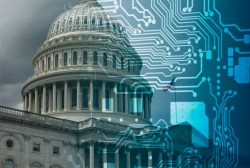Chris Liddell targets improved government services through collaboration

Chris Liddell, newly appointed assistant to the president for strategic initiatives, thinks increased collaboration — both internally and with the private sector — is key to improving government services.
In his closing keynote at Thursday night’s FedTalks, his first large-scale appearance before the government IT crowd, Liddell laid out the broad vision for President Donald Trump’s American Technology Council and the Office of American Innovation. Discontent with American government services propelled Trump to the presidency, he said, and now its amelioration is a key goal. So when speaking of the new initiatives, Liddell referred frequently to the need to modernize “government services,” a larger and more important concept, he said, than just focusing on the modernizing the underlying IT.
“Basically we formed the office to focus on large strategic projects that had three characteristics,” he said. “They had to be significant, they had to be largely bipartisan in nature and they had to be something where the White House could have a role.”
These include regulatory reform, infrastructure improvement, modernizing government services and preparing for the workforce of the future. All big topics that he said “to a large extent are bipartisan or have support and hence have the ability to make a real difference over the next four and hopefully eight years.”
And how does the White House plan to have a role? Largely, Liddell said, through the “convening power of the White House.” It’s “this ability to bring people together and achieve amazing things simply by organizing them and sort of unleashing the power that’s already there.”
People need to communicate more in government, Liddell said. “Virtually everything that the government is working on, there’s at least 12 people working away on some part of it. And the problem is that there’s a high degree of replication and duplication between these 12 people. So they’re duplicating it and occasionally getting into turf wars but then the sum total of their efforts is seldom 100 percent of what’s needed,” Liddell said, throwing some shade at government efficiency.
This “crazy situation,” Liddell alleged, has contributed to the failure of past attempts to modernize and improve government services.
But the American Technology Council and Office of American Innovation, it seems, are here to right that ship. Liddell said he’s been meeting with leaders in federal IT as well as many in private sector tech. Every Friday, a group of “40 or 50 people” get together to collaborate and “clear ideas.”
“So to a large extent, the initial days we’ve been here it’s just been getting people together and getting them to work together,” he said, mentioning meetings with the federal CIO community, including with acting U.S. CIO Margie Graves.
Liddell came across as a strong advocate for a government that draws lessons from the private sector, which makes sense given his executive past at companies like General Motors and Microsoft. “If we can bring the best thinking from the private sector and put that on top of the best thinking from inside the government in a coordinated fashion then we have a real chance of making a difference,” he said.
In a few weeks, the American Technology Council will bring together “a large number of the major technology companies to help us think about how we run the government better,” he explained — things like citizen services, cloud strategy, analytics, cybersecurity, using big data to eliminate fraud, changing the hiring process and retraining the existing workforce, bringing in more private sector talent for tours of duty and reforming technology procurement.
The aim of all this coordination and private sector collaboration, Liddell maintained, is to improve American citizens’ experience of their government.
“If we did nothing else for the next four years but make 300 million plus people’s lives better by improving the quality of the services they have that would be a phenomenal contribution,” Liddell said. “If we did nothing else but make the average person’s life 5 percent better, 10 percent better, or in some case 100 percent better, that would be a phenomenal achievement.”
But it could also save a lot of money, he said.
“What we spend on IT itself — we could be vastly more efficient if we spent the money better, if we had shared services and we had common platform and good data. For the $450 billion the government spends in non-mandatory spending, we could make a huge difference to that,” he said.
Also by chipping away at fraud and abuse using big data and machine learning, added to the efficiency savings, Liddell thinks based on his private sector experience that it would be possible to save at least “$50 billion to $100 billion a year.”






